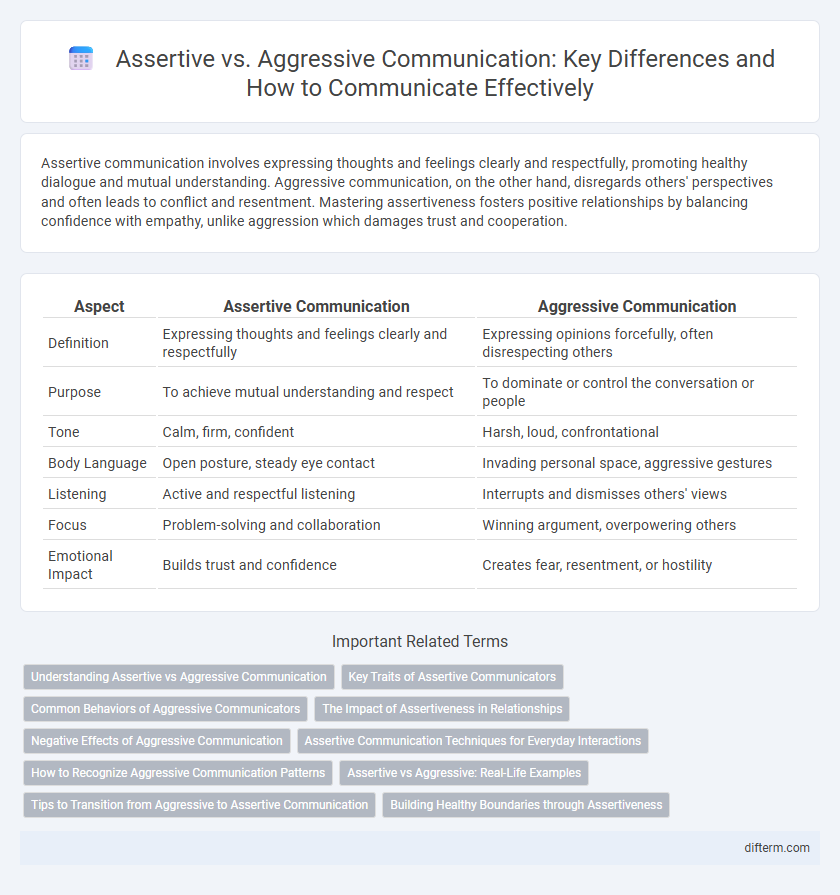Assertive communication involves expressing thoughts and feelings clearly and respectfully, promoting healthy dialogue and mutual understanding. Aggressive communication, on the other hand, disregards others' perspectives and often leads to conflict and resentment. Mastering assertiveness fosters positive relationships by balancing confidence with empathy, unlike aggression which damages trust and cooperation.
Table of Comparison
| Aspect | Assertive Communication | Aggressive Communication |
|---|---|---|
| Definition | Expressing thoughts and feelings clearly and respectfully | Expressing opinions forcefully, often disrespecting others |
| Purpose | To achieve mutual understanding and respect | To dominate or control the conversation or people |
| Tone | Calm, firm, confident | Harsh, loud, confrontational |
| Body Language | Open posture, steady eye contact | Invading personal space, aggressive gestures |
| Listening | Active and respectful listening | Interrupts and dismisses others' views |
| Focus | Problem-solving and collaboration | Winning argument, overpowering others |
| Emotional Impact | Builds trust and confidence | Creates fear, resentment, or hostility |
Understanding Assertive vs Aggressive Communication
Assertive communication involves expressing thoughts and feelings clearly and respectfully while maintaining personal boundaries, fostering mutual understanding and cooperation. Aggressive communication disregards others' rights by using forceful language or behavior to dominate or intimidate, often leading to conflict and resentment. Recognizing these differences is crucial for developing healthy interpersonal relationships and effective conflict resolution skills.
Key Traits of Assertive Communicators
Assertive communicators maintain clear, direct expression of their thoughts and feelings while respecting others' perspectives. They use confident body language, steady eye contact, and a calm tone to convey messages without hostility. Key traits include active listening, empathy, and the ability to set healthy boundaries, facilitating constructive dialogue and mutual understanding.
Common Behaviors of Aggressive Communicators
Aggressive communicators often exhibit behaviors such as interrupting others, raising their voice, and using blaming language. They tend to dominate conversations, ignore others' viewpoints, and display hostility or sarcasm. These actions create a confrontational atmosphere that hinders effective communication and damages relationships.
The Impact of Assertiveness in Relationships
Assertiveness fosters healthy communication by clearly expressing needs and boundaries, promoting mutual respect and understanding. In contrast, aggression often damages relationships through intimidation or hostility, leading to conflict and resentment. Practicing assertiveness enhances emotional connection, reduces misunderstandings, and builds trust between individuals.
Negative Effects of Aggressive Communication
Aggressive communication often leads to damaged relationships, increased conflict, and reduced trust among individuals. It creates a hostile environment where open dialogue and collaboration become difficult, ultimately hindering effective problem-solving. Persistent aggression can also cause emotional stress, lowering morale and productivity in both personal and professional settings.
Assertive Communication Techniques for Everyday Interactions
Assertive communication techniques enhance clarity and respect in everyday interactions by promoting honest expression of thoughts and feelings while considering others' viewpoints. Employing "I" statements, maintaining steady eye contact, and practicing active listening establish boundaries without hostility or passivity. Consistent use of these methods increases mutual understanding and minimizes conflicts in both personal and professional communication.
How to Recognize Aggressive Communication Patterns
Aggressive communication is characterized by a loud voice, interrupting others, and using threatening or blaming language that disregards the feelings and rights of others. Recognizing aggressive patterns includes noting behaviors such as dominating conversations, making rigid demands, and showing little empathy or willingness to listen. These signs contrast sharply with assertive communication, which respects both personal boundaries and the perspectives of all parties involved.
Assertive vs Aggressive: Real-Life Examples
Assertive communication involves expressing thoughts and feelings clearly and respectfully, such as calmly stating your needs during a team meeting without interrupting others. Aggressive communication might look like raising your voice or demanding your opinion be heard, which can create conflict and reduce collaboration. Real-life examples highlight that assertive behavior fosters positive relationships and effective problem-solving, while aggressive actions often lead to misunderstandings and tension.
Tips to Transition from Aggressive to Assertive Communication
To transition from aggressive to assertive communication, focus on using "I" statements to express feelings and needs without blaming others, such as "I feel concerned when deadlines are missed." Practice active listening to understand others' perspectives and respond calmly rather than reacting impulsively. Maintaining a steady tone of voice, controlled body language, and clear, respectful language fosters open dialogue and mutual respect.
Building Healthy Boundaries through Assertiveness
Building healthy boundaries through assertiveness involves clearly expressing personal needs and limits while respecting others' rights, fostering mutual understanding and trust. Assertive communication promotes open dialogue without hostility, reducing conflicts and enhancing relationships. Developing assertiveness skills empowers individuals to maintain self-respect and emotional wellbeing in interpersonal interactions.
assertive vs aggressive Infographic

 difterm.com
difterm.com